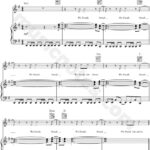Stevie Ray Vaughan’s legendary status is deeply intertwined with his iconic Fender Stratocasters. However, a lesser-known chapter in the story of the “Stevie Ray Guitar” involves Tokai guitars and a potentially fabricated endorsement deal that led to considerable controversy.
The narrative, as proposed by Craig Hopkins, suggests that during a period when an endorsement agreement was being considered, Tokai provided Stevie Ray Vaughan with several guitars as a gesture of goodwill. This included five Tokai guitars and a couple of basses, hoping to solidify a partnership. A contract dated December 30th, 1984, seemingly confirmed a Tokai endorsement. However, this document is suspected to be a forgery, with the signature and details appearing inauthentic, even featuring his wife Lenora “Lenny” as a witness.
Alt text: Close-up of Stevie Ray Vaughan passionately playing his guitar during a live performance.
This questionable contract likely formed the basis for Tokai’s 1985-86 catalog and promotional poster. The poster featured images of Stevie Ray Vaughan and Tommy Shannon playing Tokai instruments. This marketing material reportedly infuriated Stevie Ray. In a well-documented incident, when a fan presented him with the Tokai poster, Stevie Ray Vaughan emphatically wrote “I PLAY FENDER” directly over the Tokai logo, clearly stating his brand allegiance and disapproval of the perceived endorsement.
Adding another layer of complexity to the “stevie ray guitar” Tokai situation is the timing of this alleged deal. The 1984-85 period coincided with Tokai’s headstock redesign for their guitars distributed in America. Interestingly, a Tokai guitar owned by Stevie Ray Vaughan, which was sold at auction for over $20,000 and accompanied by a Certificate of Authenticity and photographic evidence, was identified as a Tokai AST model. This AST model featured a modified, non-vintage, Strat-style headstock, differing from the classic Fender design.
Alt text: Detailed view of the headstock of a Tokai AST guitar, highlighting the non-vintage Strat-style design.
This auctioned guitar appears to be one of the instruments Stevie Ray Vaughan is seen playing in the infamous Tokai poster. This evidence suggests that the promotional guitars given to Stevie Ray were likely the newly introduced 1984 AST models, rather than the earlier, more vintage-accurate Springy Sound models.
The Tokai mystery deepens further with Craig Hopkins’ assertion that Stevie Ray Vaughan is also playing a Tokai guitar on the cover of “Live at Carnegie Hall.” Photographic evidence from Chuck Pulin’s photoshoot during that iconic night does lend some credence to this claim. However, based on the available photographs, the headstock decal remains ambiguous, making it inconclusive whether it is definitively a Tokai or a Fender.
Alt text: Stevie Ray Vaughan performing live at Carnegie Hall, with a focus on his guitar, leaving the headstock decal slightly ambiguous.
In conclusion, the relationship between Stevie Ray Vaughan and Tokai guitars is a fascinating and somewhat murky episode. While Tokai may have hoped for an endorsement and even used Stevie Ray’s image for promotion, it’s clear that the legendary guitarist remained loyal to Fender. The “stevie ray guitar” story, in this instance, serves as a reminder of the importance of brand authenticity and the sometimes complex world of endorsements in the music industry.


